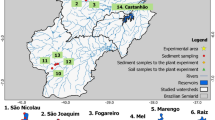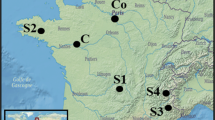Abstract
Nutrient export through sediment is, often, not given due attention in improving the fertility of soils. A Randomized Complete Block Design (RCBD) (replicated three times) was conducted to assess the effect of sediment, collected from a microdam, on the yield of a local wheat cultivar (Triticum aestivum) grown on a Luvisol and a Vertisol during cropping season of 2003 and 2004 in Tigray, Ethiopia. In the first season, the treatments consisted of applying 34.3 Mg sediment ha−1 (T1), 0.1 Mg urea ha−1 (T2), 4 Mg manure ha−1 (T3) and a control plot (T4). The experiment was repeated in the 2004 cropping season using the same indicator crop but without the use of T1 and T3 inputs to evaluate the residual effect of these treatments on crop productivity. Plant height, plant density, spike length, straw and grain yield were compared among the treatments. After harvest, surface soil (0–25 cm) samples were taken and analyzed for total Nitrogen (Ntot), available Phosphorous (P), Soil Organic Carbon (SOC), Cation Exchange Capacity (CEC), and porosity to examine treatments effect on these soil properties. Higher CEC, exchangeable bases, SOC, Ntot, available P and micronutrients except Cu characterized sediment compared to the two soils used. Application of sediment increased the average grain and straw yield of wheat by 72% and 12%, respectively, in the Luvisol, and by 38% and 23%, respectively, in the Vertisol relative to the control. However, the application of sediment didn’t change the physicochemical properties of the Vertisol, but in the Luvisol CEC and available P were increased significantly. Like manure, sediment provided marginal rate of return above the minimum acceptable value (100%) by farmers, demonstrating the potential of these resources to improve degraded soils and boost farmers’ income.



Similar content being viewed by others
References
Asumadu H, Sallah PYK, Boa-Amponsem PB, Allou J, Manu-Aduening, Osei-Bonsu (2004) On-farm evaluation and promotion of quality protein maize hybrids in Ghana. In: African crop science proceedings, vol 4. African Crop Science Society, pp. 358–364
Behailu M (2002) Assessment and optimization of traditional irrigation of Vertisols in Northern Ethiopia. A case study at Gum Selassa microdam using maize as indicator crop. PhD Thesis, Belgium. Gent 12:203
Black CA, Evans DD, White JL, Ensminger LE, Clark FE (1965) Methods of soil analysis. Part 1. Physical and mineralogical properties including statistics of measurement and sampling. American Society of Agronomy, Madison
Bojo J, Cassells D (1995) Land degradation and rehabilitation in Ethiopia: a reassessment. The World Bank, Environmentally Sustainable Development Division, AFTES working paper no. 17, Washington, DC
BOPED (1995) Five year development plan of the Tigray region. Bureau of Planning and Economic Development (BOPED), Mekelle
Brady NC (2002) The nature and properties of soils, 12th edn. Macmillan Inc, New York
Bremner JM, Mulvaney CS (1982) Nitrogen total. In: Page AL, Miller RH, Keeny DR (eds) Method of soil analysis. II. Chemical and microbiological properties, agronomic monograph, no. 9, 2nd edn. SSSA, Madison, pp 592–624
YT CIMM (1988) From agronomic data to farmer recommendations: an economics training manual (completely revised edition). CIMMYT, Mexico, DF, pp 9–38
Donahue RL, Miller RW, Schickluna JC (1983) An introduction to soils and plant growth, 5th edn. Prentice-Hall Inc., Englewood Cliffs, pp 667
Ehui S, Rey B (1990) Partial budget analysis for on-station and on-farm small ruminant production systems research: method and data requirements. In: Rey B, Lebbie SHB, Reynolds L (eds) Proceeding of the first biennial of the Africa small ruminant research network. www.fao.org/wairdocs/ILRI
Elias EA, Salih AA, Alaily F (2001) Cracking patterns in the Vertisols of the Sudan Gezira at the end of dry season. Int Agrophys 15:151–155
Fonseca R, Barriga FJAS, Fyfe WS (1998) Reversing desertification by using dam reservoir sediments as agriculture soils. Episodes 21(4):218–224
Food and Agriculture Organization of the United Nations (FAO) (1990) Integrated plant nutrient systems: state of the art. Commission on Fertilizers, 11th session, 4–6 April 1990, Rome
Food and Agriculture Organization of the United Nations (FAO) (1993) Fertilizer year book, vol 42. FAO, Rome
Hagos F, Makombe G, Namara RE, Awulachew SB (2008) Importance of irrigated agriculture to the Ethiopian economy: capturing the direct net benefits of irrigation. International Water Management Institute (IWMI) Subregional Office for the Nile Basin and East Africa. Draft report, Addis Ababa, Ethiopia
Haileslassie A, Priess J, Veldkamp E, Teketay D, Lesschen JP (2005) Assessment of soil nutrient depletion and its spatial variability on small holders’ mixed farming systems in Ethiopia using partial versus full nutrient balances. Agric Ecosyst Environ 108:1–16. doi:10.1016/j.agee.2004.12.010
Haregeweyn N, Poesen J, Nyssen J, DE Wit J, Haile M, Govers G, Deckers S (2006) Reservoirs in Tigray (Northern Ethiopia): characteristics and sediment deposition problems. Land Degrad Dev 17:211–230. doi:10.1002/ldr.698
Haregeweyn N, Poesen J, Deckers J, Nyssen J, Haile M, Govers G, Verstraeten G, Moeyersons J (2008) Sediment-bound nutrient export from micro-dam catchments in Northern Ethiopia. Land Degrad Dev 19:136–152. doi:10.1002/ldr.830
Havlin JL, Tisdale SL, Beaton JD, Nelson WL (2005) Soil fertility and fertilizers an introduction to nutrient management, 7th edn. Prentice-Hall Inc., Englewood Cliffs
Hengsdijk H, Meijerink GW, Mosugu ME (2005) Modelling the effect of three soil and water conservation practices in Tigray, Ethiopia. Agric Ecosyst Environ 105:29–40. doi:10.1016/j.agee.2004.06.002
Jackson ML (1967) Soil chemical analysis. Prentice Hall of India Pvt. Ltd, New Delhi
JMP (2002) SAS Institute Inc., SAS Campus Drive, Cary, NC, USA
Kempe S (1983) Impact of Aswan High Dam on water chemistry of the Nile. In: Nyssen J (2001) Erosion processes and soil conservation in tropical mountain catchment under threat of anthropogenic desertification—a case study from Northern Ethiopia. PhD Thesis, Katholieke University Leuven, Belgium
Landon RJ (1991) Booker tropical soil manual. A handbook for soil survey and agricultural land evaluation in the tropics and subtropics. Longman Scientific and Technical Publishing, New York
Latham M, Ahn PM (1988) Management of Vertisol in Sub-Saharan Africa. In: Vertisols management. Proceedings of conference, ILCA, Addis Abeba, 31 August–September 4 1987
Lindsey WL, Norwell WA (1978) Development of DTPA soil test for zinc, iron, manganese and copper. Soil Sci Soc Am J 42:421–428
Makinde EA, Saka JO, Makinde JO (2007) Economic evaluation of soil fertility management options on cassava-based cropping systems in the rain forest ecological zone of south western Nigeria. Afr J Agric Res 2:007–013
Mochizuki A, Homma K, Horie T, Shiraiwa T, Watatsu E, Supapoj N, Throngtha C (2006) Increased productivity of rainfed lowland rice by incorporation of pond sediments in Northeast Thailand. Field Crops Res 96:422–427. doi:10.1016/j.fcr.2005.08.007
Mutsaers HJW, Fisher NM, Vogel WO, Palada MC (1986) Farming systems program: a field guide for on-farm research with special reference to improvement of cropping systems and technologies in West and Central Africa. International Institute of Tropical Agriculture, Ibadab, pp 197
National Bank of Ethiopia (2003/2004) National Bank of Ethiopia—annul report 2003/2004. http://www.nbe.gov.et/
Olsen SR, Sommers LE (1982) Phosphorous. In: Page AL, Miller RH, Keeny DR (eds) Method of soil analysis. II. Chemical and microbiological properties, agronomic monograph, no. 9, 2nd edn. SSSA, Madison
Pimentel D, Allen J, Beers A, Guinand L, Hawkins A, Linder R, Mclaughlin P, Meer B, Musonada D, Poisson S, Salazar R, Siebert S, Stoner K (1993) Soil erosion and agriculture productivity. Cambridge University Press, Great Britain
Probst JL, Amiotte-Suchet P, Ludwig W (1994) Continental erosion and river transports of carbon to oceans. Trend in hydrology. In: Nyssen J (2001) Erosion processes and soil conservation in tropical mountain catchment under threat of anthropogenic desertification—a case study from Northern Ethiopia. PhD Thesis, Katholieke University
Sharpley AN, Troeger WW, Smith SJ (1991) The measurement of bioavailable phosphorous in agricultural run off. J Environ Qual 20:235–238
Stoorvogel JJ, Smaling EMA (1990) Assessment of soil nutrient depletion in Sub-Saharan Africa: 1983–2000, vol 1. Main report, The Winand Staring Centre, report no. 28, Wageningen, The Netherlands
Tamene L, Park SJ, Dikau R, Vlek PLG (2006) Reservoir siltation in the semi-arid highlands of northern Ethiopia: sediment yield–catchment area relationship and a semi-quantitative approach for predicting sediment yield. Earth Surf Process Landf 31:1364–1383. doi:10.1002/esp.1338
Vancampenhout K, Nyssen J, Gebremichael D, Deckers J, Poesen J, Haile M, Moeyersons J (2006) Stone bunds for soil conservation in the Northern Ethiopia highlands: impacts on soil fertility and crop yield. Soil Tillage Res 90:1–15. doi:10.1016/j.still.2005.08.004
Verstraeten G, Poesen J (2002) Assessment of sediment-fixed nutrient exports from small drainage basins in central Belgium using retention ponds. IAHS Publication, Wallingford
Wan Y, EI-Swaify SA (1998) Sediment enrichment mechanisms of organic carbon and phosphorous in a well-aggregated Oxisol. J Environ Qual 27:132–138
Wendimagegnew F (2002) Soil water requirements and response to fertilization of Barley in Northern Ethiopia. PhD Thesis, Department of Horticulture and Crop Sciences, Agricultural University of Norway
Acknowledgement
This research was conducted through the financial support of WHO-SAREC project at Mekelle University. The authors wish to thank the project for their financial support. A special gratitude goes to the farmers of Gum Selassa who were involved in the research activities and gave us their plots to conduct this research. We also express our gratitude to Dr. Fistum Hagos (Development and Resource Economist) for his comments on the economic analysis part of the manuscript. The authors wish to thank the anonymous reviewers for their constructive and professional comments. Finally, the first author is grateful to the Norweigan State Educational Loan Fund (Lånekassen) for providing financial assistance.
Author information
Authors and Affiliations
Corresponding author
Rights and permissions
About this article
Cite this article
Girmay, G., Mitiku, H. & Singh, B.R. Agronomic and economic performance of reservoir sediment for rehabilitating degraded soils in Northern Ethiopia. Nutr Cycl Agroecosyst 84, 23–38 (2009). https://doi.org/10.1007/s10705-008-9222-y
Received:
Accepted:
Published:
Issue Date:
DOI: https://doi.org/10.1007/s10705-008-9222-y




